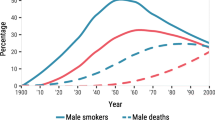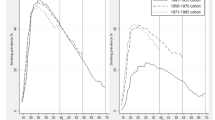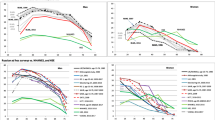Abstract
Widening of educational disparities and a narrowing female advantage in mortality stem in good part from disparities in smoking. The changes in smoking and mortality disparities across cohorts and countries have been explained by an epidemic model of cigarette use but are also related to life course changes. To better describe and understand changing disparities over the life course, we compare age patterns of smoking in three cohorts and two nations (France and the US) using smoking history measures from the 2010 French health barometer (N = 20,940) and the 2010 US National Health Interview Survey Sample Adult File (N = 20,444). The results demonstrate statistically significant widening of gender and educational differences from adolescence to early and middle adulthood, thus accentuating the disparities already emerging during adolescence. In addition, the widening disparities over the life course have been changing across cohorts: age differences in educational disparities have grown in recent cohorts (especially in France), while age differences in gender disparities have narrowed. The findings highlight the multiple sources of inequality in smoking and health in high-income nations.



Similar content being viewed by others
References
Ai, C., & Norton, E. C. (2003). Interaction terms in logit and probit models. Economics Letters, 80(1), 123–129.
Allison, P. D. (1982). Discrete-time methods for the analysis of event histories. Sociological Methodology, 13(1), 61–98.
Allison, P. D. (1999). Comparing logit and probit coefficients across groups. Sociological Methods and Research, 28, 186–208.
Bachman, J. G., O’Malley, P. M., Schulenberg, J. E., Johnston, L. D., Bryant, A. L., & Merlin, A. C. (2002). The decline of substance use in young adulthood: Changes in social activities, roles, and beliefs. Mahwah, NJ: Lawrence Erlbaum.
Beck, F., Gautier, A., Guignard, R., & Richard, J.-B. (2011a). Une méthode de prise en compte du dégroupage total dans le plan de sondage des enquêtes téléphoniques auprès des ménages. In M.-E. Tremblay, P. Lavallée, & M. El Hadj Tirari (Eds.), Pratiques et méthodes de sondage (pp. 310–314). Paris: Dunod.
Beck, F., Guignard, R., Richard, J.-B., Tovar, M.-L., & Spilka, S. (2011b). Les niveaux d’usage des drogues en france en 2010—exploitation des données du baromètre santé. Tendances, 76, 1–6.
Bilal, U., Fernández, E., Beltran, P., Navas-Acien, A., Bolumar, F., & Franco, M. (2014). Validation of a method for reconstructing historical rates of smoking prevalence. American Journal of Epidemiology, 179(1), 15–19.
Bosdriesz, J. R., Willemsen, M. C., Stronks, K., & Kunst, A. E. (2015). Socioeconomic inequalities in smoking cessation in 11 European countries from 1987 to 2012. Journal of Epidemiology and Community Health, 69, 886–892.
Bricard, D., Jusot, F., Beck, F., Khlat, M., & Legleye, S. (2015). Educational inequalities in smoking over the lifecycle: An analysis by cohort and gender. International Journal of Public Health, 61(1), 101–109.
Businelle, M. S., Kendzor, D. E., Reitzel, L. R., Costello, T. J., Cofta-Woerpel, L., Li, Y., et al. (2010). Mechanisms linking socioeconomic status to smoking cessation: A structural equation modeling approach. Health Psychology, 29(3), 262–273.
Chassin, L., Presson, C. C., Pitts, S. C., & Sherman, S. J. (2000). The natural history of cigarette smoking from adolescence to adulthood in a Midwestern community sample: Multiple trajectories and their psychosocial correlates. Health Psychology, 19, 222–231.
Chen, P., & Jacobson, K. C. (2011). Developmental trajectories of substance use from early adolescence to young adulthood: Gender and racial/ethnic differences. Journal of Adolescent Health, 50, 154–163.
Christopoulou, R., Han, J., Jaber, A., & Lillard, D. (2011). Dying for a smoke: How much does differential mortality of smokers affect estimated life-course smoking prevalence? Preventive Medicine, 52(1), 66–70.
Costello, D. M., Dierker, L. C., Jones, B. L., & Rose, J. S. (2008). Trajectories of smoking from adolescence to early adulthood and their psychosocial risk factors. Health Psychology, 27, 811–818.
Dinno, A., & Glantz, S. (2009). Tobacco control policies are egalitarian: A vulnerabilities perspective on clean indoor air laws, cigarette prices, and tobacco use disparities. Social Science and Medicine, 68(8), 1439–1447.
DiPrete, T. A., & Eirich, G. M. (2006). Cumulative advantage as a mechanism for inequality: A review of theoretical and empirical developments. Annual Review of Sociology, 32, 271–297.
Droomers, M., Schrijvers, C. T. M., Casswell, S., & Mackenbach, J. P. (2005). Father’s occupational group and daily smoking during adolescence: Patterns and predictors. American Journal of Public Health, 95, 681–688.
Elder, G. H., Jr. (1994). Time, human agency, and social change: Perspectives on the life course. Social Psychological Quarterly, 57, 4–15.
Ferrence, R. G. (1989). Deadly fashion: The rise and fall of cigarette smoking in North America. New York: Garland Publishing.
Forey, B., Hamling, J., Hamling, J., Thornton, A., & Lee, P. (2016). International smoking statistics: WEB edition 2006–2015. http://www.pnlee.co.uk/ISS3.htm.
Frohlich, K. L., & Potvin, L. (2008). The inequality paradox: The population approach and vulnerable populations. American Journal of Public Health, 98, 216–221.
Giskes, K., Kunst, A. E., Benach, J., Borrell, C., Costa, G., Dahl, E., et al. (2005). Trends in smoking behaviour between 1985 and 2000 in nine European countries by education. Journal of Epidemiology and Community Health, 59, 395–401.
Glei, D. A., & Horiuchi, S. (2007). The narrowing sex differential in life expectancy in high-income populations: Effects of differences in the age pattern of mortality. Population Studies, 61(2), 141–159.
Graham, H., Hawkins, S. S., & Law, C. (2010). Life course influences on women’s smoking before, during and after pregnancy. Social Science and Medicine, 70, 582–587.
Griesbach, D., Amos, A., & Currie, C. (2003). Adolescent smoking and family structure in Europe. Social Science and Medicine, 56, 41–52.
Hanson, M. D., & Chen, E. (2007). Socioeconomic status and health behaviors in adolescence: A review of the literature. Journal of Behavioral Medicine, 30, 263–285.
Harman, J., Graham, H., Francis, B., Inskip, H. M., & The SWS Study Group. (2006). Socioeconomic gradients in smoking among young women: A British survey. Social Science and Medicine, 63, 2791–2800.
Hibeli, B., Guttormsson, U., Ahlström, S., Balakireva, O., Bjarnason, T., Kokkevi, A., & Kraus, L. (2012). The 2011 ESPAD report: Substance use among students in 36 European countries. http://espad.org/Uploads/ESPAD_reports/2011/The_2011_ESPAD_Report_FULL_2012_10_29.pdf.
Hu, M.-C., Muthén, B., Schaffran, C., Griesler, P. C., & Kandel, D. B. (2008). Developmental trajectories of criteria of nicotine dependence in adolescence. Drug and Alcohol Dependence, 98, 94–104.
Ingall, G., & Cropley, M. (2010). Exploring the barriers of quitting smoking during pregnancy: A systematic review of qualitative studies. Women and Birth, 23, 45–52.
Jacobson, P., Lantz, P. M., Warner, K. E., Wasserman, J., Pollack, H. A., & Ahlstrom, A. K. (2001). Combating teen smoking: Research and policy strategies. Ann Arbor, MI: University of Michigan Press.
Jha, P., Peto, R., Zatonski, W., Boreham, J., Jarvis, M. J., & Lopez, A. D. (2006). Social inequalities in male mortality, and in male mortality from smoking: Indirect estimation from national death rates in England and Wales, Poland, and North America. Lancet, 368, 367–370.
Johnston, L. D. (2001). Changing demographic patterns of adolescent smoking over the past 23 years: National trends from the Monitoring the Future study. Smoking and Tobacco Control Monograph, 14, 9–33.
Johnston, L. D., O’Malley, P. M., Miech, R. A., Bachman, J. G., & Schulenberg, J. E. (2014). Monitoring the future national results on drug use: 1975–2013: Overview, key findings on adolescent drug use. Ann Arbor, MI: Institute for Social Research, University of Michigan.
Kerckhoff, A. C., Ezell, E. D., & Brown, J. S. (2002). Toward an improved measure of educational attainment in social stratification research. Social Science Research, 31(1), 99–123.
Lacey, R. E., Cable, N., Stafford, M., Bartley, M., & Pikhart, H. (2010). Childhood socio-economic position and adult smoking: Are childhood psychosocial factors important? Evidence from British birth cohort. European Journal of Public Health, 21, 725–731.
Legleye, S., Khlat, M., Beck, F., & Peretti-Watel, P. (2011). Widening inequalities in smoking initiation and cessation patterns: A cohort and gender analysis in France. Drug and Alcohol Dependence, 117(2–3), 233–241.
Lopez, A. D., Collishaw, N. E., & Piha, T. (1994). A descriptive model of the cigarette epidemic in developed countries. Tobacco Control, 3(3), 242–247.
Luy, M., & Wegner-Siegmundt, C. (2015). The impact of smoking on gender differences in life expectancy: More heterogeneous than often stated. European Journal of Public Health, 25(4), 706–710.
Mackenbach, J. P. (2012). The persistence of health inequalities in modern welfare states: The explanation of a paradox. Social Science and Medicine, 75, 761–769.
Mackenbach, J., Huisman, M., Andersen, O., Bopp, M., Borgan, J.-K., Borrell, C., et al. (2004). Inequalities in lung cancer mortality by educational level in 10 European populations. European Journal of Cancer, 40, 126–135.
Maralani, V. (2013). Educational inequalities in smoking: The role of initiation versus quitting. Social Science and Medicine, 84, 129–137.
Masters, R. K., Link, B. G., & Phelan, J. C. (2015). Trends in education gradients of ‘preventable’ mortality: A test of fundamental cause theory. Social Science and Medicine, 127, 19–28.
Montez, J. K., & Barnes, K. (2016). The benefits of educational attainment for U.S. adult mortality: Are they contingent on the broader environment? Population Research and Policy Review, 35, 73–100.
Montez, J. K., Hummer, R. A., Hayward, M. D., Woo, H., & Rogers, R. G. (2011). Trends in the educational gradient of U.S. adult mortality from 1986 through 2006 by race, gender, and age group. Research on Aging, 33(2), 145–171.
Moon-Howard, J. (2003). African-American women and smoking: Starting later. American Journal of Public Health, 93(3), 418–420.
National Center for Health Statistics. (2013). 2010 National Health Interview Survey (NHIS) public use data release: NHIS survey description.ftp://ftp.cdc.gov/pub/Health_Statistics/NCHS/Dataset_Documentation/NHIS/2010/srvydesc.pdf .
Nichter, M. (2015). Lighting up: The rise of social smoking on college campuses. New York: NYU Press.
Oaks, L. (2001). Smoking and pregnancy: The politics of fetal protection. New Brunswick, NJ: Rutgers University Press.
Pampel, F. C. (2002). Inequality, diffusion, and the status gradient in smoking. Social Problems, 49, 35–57.
Pampel, F. C. (2003). Declining sex differences in lung cancer mortality in high income nations. Demography, 40, 45–65.
Pampel, F. C. (2005). Diffusion, cohort change, and social patterns of smoking. Social Science Research, 34, 117–139.
Pampel, F., Legleye, S., Goffette, C., Pointek, D., Kraus, L., & Khlat, M. (2015). Cohort changes in educational disparities in smoking: France, Germany and the United States. Social Science and Medicine, 127, 41–50.
Pampel, F. C., Mollborn, S., & Lawrence, E. A. (2014). Life course transitions in early adulthood and SES disparities in tobacco use. Social Science Research, 43, 45–59.
Pappas, G., Queen, S., Hadden, W., & Fisher, G. (1993). The increasing disparity in mortality between socioeconomic groups in the United States, 1960 and 1986. New England Journal of Medicine, 329, 103–109.
Peretti-Watel, P., & Constance, J. (2009). ‘It’s all we got left’: Why poor smokers are less sensitive to cigarette price increases. International Journal of Environmental Research and Public Health, 6(2), 608–621.
Peretti-Watel, P., Constance, J., Seror, V., & Beck, F. (2009). Working conditions, job dissatisfaction and smoking behaviours among French clerks and manual workers. Journal of Occupational and Environmental Medicine, 51(3), 343–350.
Potter, B. K., Pederson, L. L., Chan, S. S. H., Aubut, J.-A. L., & Koval, J. J. (2004). Does a relationship exist between body weight, concerns about weight, and smoking among adolescents? An integration of the literature with an emphasis on gender. Nicotine and Tobacco Research, 6(3), 397–425.
Reid, J. L., Hammond, D., Boudreau, C., Fong, G., & Siahpush, M. (2010). Socioeconomic disparities in quit intentions, quit attempts, and smoking abstinence among smokers in four western countries: Findings from the international tobacco control four country survey. Nicotine and Tobacco Research, 12(Suppl. 1), S20–S33.
Rose, G. (1985). Sick individuals and sick populations. International Journal of Epidemiology, 14, 32–38.
Rose, G. (1992). The strategy of preventive medicine. Oxford: Oxford University Press.
Schaap, M., Kunst, A., Leinsalu, M., Regidor, E., Ekholm, O., Dzurova, D., et al. (2008). Effect of nation-wide tobacco control policies on smoking cessation in high and low educated groups in 18 European countries. Tobacco Control, 17, 248–255.
Slovic, P. (Ed.). (2001). Smoking: Risk, perception, and policy. Thousand Oaks, CA: Sage.
Soteriades, E. S., & DiFranza, J. R. (2003). Parent’s socioeconomic status, adolescents’ disposable income, and adolescents’ smoking status in Massachusetts. American Journal of Public Health, 93, 1155–1160.
Staff, J., Schulenberg, J. E., Maslowsky, J., Bachman, J. G., O’Malley, P. M., Maggs, J. L., et al. (2010). Substance use changes and social role transitions: Proximal developmental effects on ongoing trajectories from late adolescence through early adulthood. Development and Psychopathology, 22, 917–932.
Thomas, S., Fayter, D., Misso, K., Ogilvie, D., Petticrew, M., Sowden, A., et al. (2008). Population tobacco control interventions and their effects on social inequalities in smoking: Systematic review. Tobacco Control, 17, 230–237.
Thun, M. J., Carter, B. D., Feskanich, D., Freedman, N. D., Prentice, R., Lopez, A. D., et al. (2013). 50-Year trends in smoking-related mortality in the United States. New England Journal of Medicine, 368, 351–364.
Thun, M., Peto, R., Boreham, J., & Lopez, A. D. (2012). Stages of the cigarette epidemic on entering its second century. Tobacco Control, 21, 96–101.
Tuinstra, J., Groothoff, J. W., van den Heuval, W., & Post, D. (1998). Socio-economic differences in health risk behavior in adolescence: Do they exist? Social Science and Medicine, 47, 67–74.
Umberson, D., Crosnoe, R., & Reczek, C. (2010). Social relationships and health behavior across the life course. Annual Review of Sociology, 36, 139–157.
UNESCO Institute for Statistics. (2015). ISCED 2011 operational manual: Guidelines for classifying national education programmes and related qualifications. Paris: OECD Publishing. doi:10.1787/9789264228368-en.
U.S. Department of Health and Human Services (USDHHS). (2014). Smoking—50 Years of progress: A report of the Surgeon General. Rockville, MD: U.S. Department of Health and Human Services, Public Health Service, Office of the Surgeon General.
Willson, A. E., Shuey, K. M., & Elder, G. H., Jr. (2007). Cumulative advantage processes as mechanisms of inequality in life course health. American Journal of Sociology, 112, 1886–1924.
Wong, M. D., Shapiro, M. F., Boscardin, W. J., & Ettner, S. L. (2002). Contribution of major diseases to disparities in mortality. New England Journal of Medicine, 347, 1585–1592.
World Health Organization (WHO). (2016). Deaths from tobacco in Europe. http://www.euro.who.int/en/health-topics/disease-prevention/tobacco/news/news/2012/04/deaths-from-tobacco-in-europe.
Zajacova, A., Walsemann, K. M., & Dowd, J. B. (2015). The long arm of adolescent health among men and women: Does attained status explain its association with mid-adulthood health? Population Research and Policy Review, 34, 19–48.
Acknowledgements
This Project received travel support from the Institut National d’Etudes Demographiques Direction des Relations Internationales et des Partenariates, and funding from the Institut National d’Etudes Demographiques and Institut National du Cancer (COTCEDIS Project “Consommation de tabac et de cannabis: evolution et dynamiques de construction des inegalites sociales,” Grant No. 2011-250).
Author information
Authors and Affiliations
Corresponding author
Additional information
The original version of this article was revised. The equation under the section Educational Differences over the Life Course has been mentioned incorrectly in the original version. It is corrected in the article.
An erratum to this article is available at http://dx.doi.org/10.1007/s11113-017-9428-2.
Rights and permissions
About this article
Cite this article
Pampel, F.C., Bricard, D., Khlat, M. et al. Life Course Changes in Smoking by Gender and Education: A Cohort Comparison Across France and the United States. Popul Res Policy Rev 36, 309–330 (2017). https://doi.org/10.1007/s11113-016-9424-y
Received:
Accepted:
Published:
Issue Date:
DOI: https://doi.org/10.1007/s11113-016-9424-y




